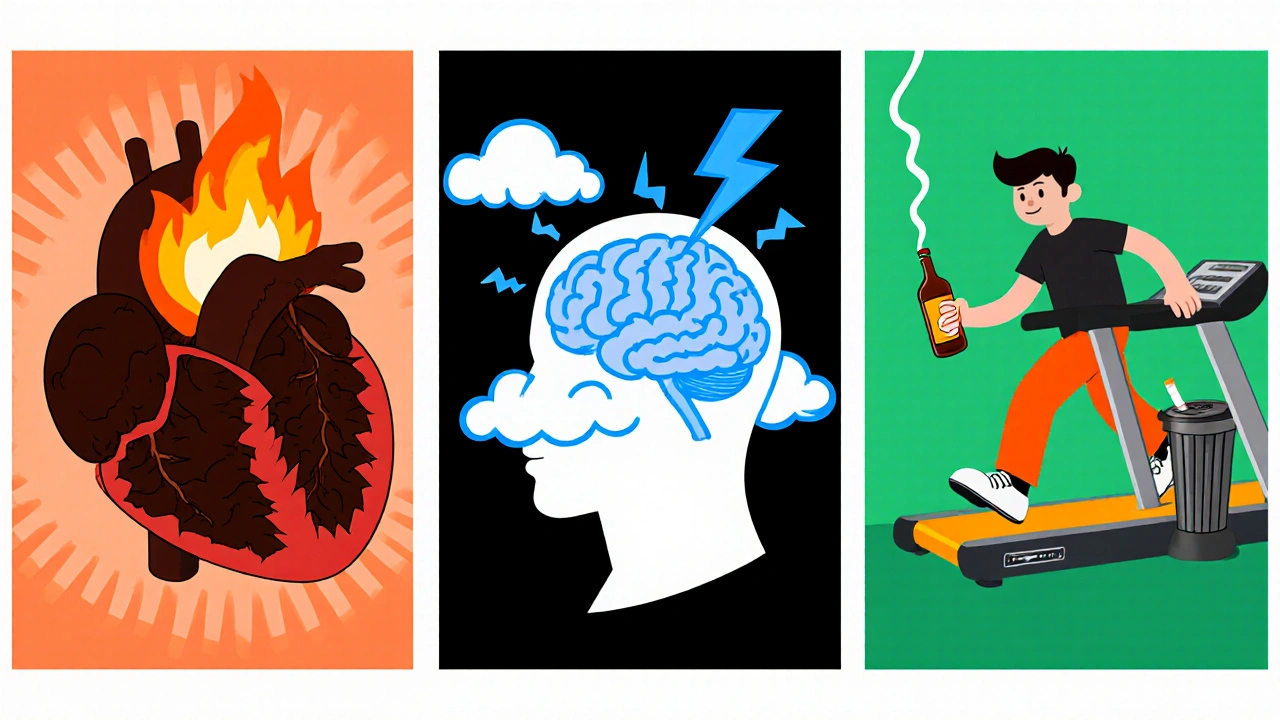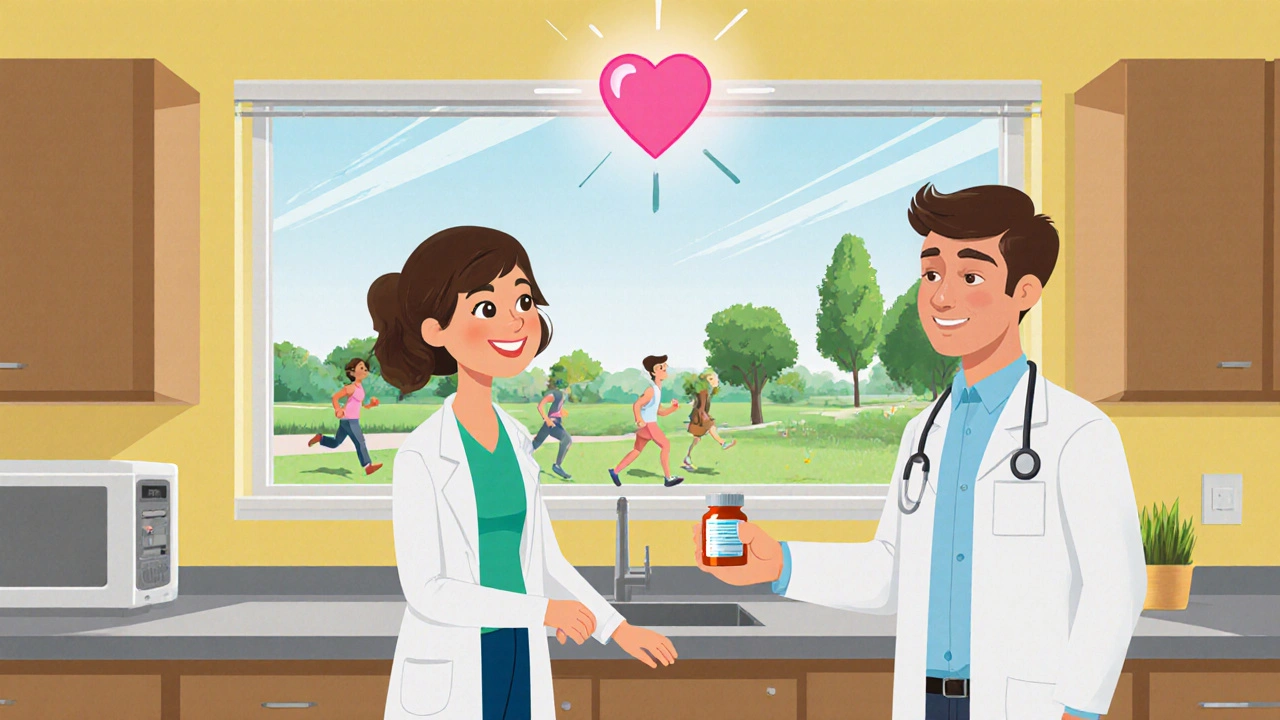ED Myth Buster Quiz
How Much Do You Know About ED?
1. Only older men get erectile dysfunction.
2. Which of these is a common physical cause of ED?
3. What is the typical success rate for oral PDE5 inhibitors like Viagra?
4. Can lifestyle changes alone cure erectile dysfunction?
5. Why is partner involvement important in ED treatment?
When talking about Impotence is a medical condition marked by the repeated inability to achieve or maintain an erection suitable for sexual activity, the first thing most people notice is the silence around it. That silence isn’t natural; it’s a wall built from stereotypes, outdated beliefs, and fear of judgment. This article pulls down those walls, explains why the myths persist, and shows practical ways to break the cycle.
What Impotence Really Is
Medical professionals prefer the term Erectile dysfunction (ED) because it describes the physiological process without the blame‑laden language of "impotence." The condition affects about 30 million men in the United States alone and a comparable proportion worldwide, according to recent epidemiological data. It isn’t a sign of personal failure; it’s usually a symptom of an underlying issue.
Common Misconceptions and Why They Stick
Below are the top myths you’ll hear, plus the facts that debunk them.
- Myth: Only older men get erectile dysfunction.
Fact: While prevalence rises with age, men in their 20s and 30s can experience it, often due to stress, anxiety, or hormonal imbalances. - Myth: It’s always a "mind" problem.
Fact: Physical causes-like Cardiovascular disease (reduced blood flow due to clogged arteries) or low Testosterone (the primary male sex hormone) levels-play a major role. - Myth: It’s untreatable.
Fact: A range of medically approved options, from PDE5 inhibitors (oral drugs like Viagra and Cialis that improve blood flow) to lifestyle changes, can restore function for most men. - Myth: Using a medication means you’re “cheating” on your partner. Fact: Treatment is a shared health decision, much like taking medication for hypertension. Open conversation reduces shame.
Root Causes: Physical, Psychological, and Lifestyle Factors
Understanding the root cause helps choose the right solution. Causes usually fall into three buckets.
Physical Triggers
Conditions that affect blood vessels or nerves are prime suspects. Common culprits include:
- Diabetes (high blood sugar that damages blood vessels and nerves)
- Hypertension (high blood pressure that narrows arteries)
- Obesity (excess body fat that interferes with hormone balance)
Psychological Triggers
Stress, performance anxiety, and past trauma are powerful inhibitors. Even a single night of poor sleep can tip the balance. When the brain sends “fight or flight” signals, blood reroutes away from the genital area, making an erection difficult.
Lifestyle Triggers
Smoking, excessive alcohol, and sedentary habits all shrink or stiffen blood vessels. On the flip side, regular exercise, a balanced diet, and proper sleep can dramatically improve erectile health.
Treatment Paths: Medical, Behavioral, and Holistic Options
There’s no one‑size‑fits‑all plan. Here’s how the main approaches stack up.
| Approach | How It Works | Typical Success Rate | Key Considerations |
|---|---|---|---|
| Oral PDE5 inhibitors | Boosts nitric oxide, widening blood vessels | 70‑80% | Must be taken 30‑60 min before sex; contraindicated with certain heart meds |
| Injection therapy | Directly delivers medication to penile tissue | 85‑90% | Requires training; risk of bruising |
| Vacuum erection device | Creates negative pressure to draw blood in | 60‑70% | Can feel mechanical; need partner support |
| Psychological counseling | Addresses anxiety, relationship issues | Varies; often improves outcomes when combined with meds | Requires regular sessions; stigma may deter some men |
| Lifestyle modification | Exercise, diet, quit smoking | Improvement seen in 40‑60% over 12 weeks | Needs sustained commitment |
For many, a combination works best. A doctor might prescribe a low‑dose PDE5 inhibitor while a therapist tackles performance anxiety, and a fitness plan restores cardiovascular health.
How to Talk About Impotence Without Shame
Conversation is the hardest part, but it’s also the most powerful tool.
- Choose a neutral setting. A relaxed evening at home works better than a rushed bathroom chat.
- Use factual language. Replace “impotence” with “erectile difficulty” to keep the tone clinical.
- Invite, don’t demand. Say, "I’ve noticed something and I’d like us to explore it together," rather than "You’re not performing."
- Bring data. Mention that 1 in 10 men under 40 experience it; that normalizes the experience.
- Plan next steps together. Whether it’s a doctor’s appointment, a therapist session, or a joint workout plan, mutual commitment reduces isolation.
When partners communicate openly, the emotional burden drops, making medical or lifestyle interventions more effective.

Partner Involvement: The Missing Piece
Most treatment guidelines stress the role of Partner communication. A supportive partner can help reduce anxiety, remind the patient to take medication, and share in healthy habits like walking or cooking balanced meals. Studies show that couples who engage in joint counseling report a 30 % higher satisfaction rate after treatment.
Practical Tips for Everyday Life
- Exercise regularly. Aim for at least 150 minutes of moderate cardio per week; it enhances blood flow.
- Watch your diet. Foods rich in flavonoids (berries, citrus) improve vascular health.
- Quit smoking. Nicotine constricts vessels and lowers nitric oxide levels.
- Limit alcohol. More than two drinks a day can blunt nerve signals.
- Practice pelvic floor exercises. Known as Kegels, they strengthen muscles that aid erection rigidity.
- Manage stress. Mindfulness, deep‑breathing, or a short daily meditation reduces cortisol spikes.
These steps may feel small, but together they create a foundation that supports any medical treatment you choose.
When to Seek Professional Help
If you experience any of the following, book an appointment promptly:
- Difficulty achieving an erection more than three times a month.
- Pain during or after intercourse.
- Sudden changes after a major health event (heart attack, stroke).
- Persistent anxiety or depression linked to sexual performance.
A primary care physician can run basic labs (testosterone, glucose, lipid profile) and refer you to a urologist or therapist as needed.
Closing Thoughts: Turning Stigma into Support
Stigma thrives on silence. By naming the condition, sharing facts, and fostering honest conversation, we replace shame with empowerment. Whether you’re the person experiencing impotence, a partner, or a health professional, the goal is the same: create a space where treatment is a normal, health‑focused decision rather than a source of embarrassment.

Is erectile dysfunction always a sign of aging?
No. While prevalence rises with age, younger men can experience it due to stress, hormonal issues, or lifestyle factors. Early evaluation helps address reversible causes.
Can lifestyle changes alone cure erectile dysfunction?
Lifestyle tweaks-regular exercise, balanced diet, quitting smoking-can improve symptoms for many men, especially when the root cause is vascular. However, severe cases often need medication or therapy in addition.
Are PDE5 inhibitors safe for everyone?
They’re safe for most men but contraindicated for those taking nitrates for heart disease or with certain eye conditions. A doctor should review all medications before prescribing.
How does counseling help with impotence?
Therapy tackles performance anxiety, past trauma, and relationship dynamics. When emotional blocks are removed, physical treatments become more effective, often boosting success rates by 20‑30%.
Should partners be involved in the treatment plan?
Yes. Partners provide emotional support, help track medication adherence, and can join lifestyle changes like exercising together. Joint counseling improves communication and intimacy.

Nikita Shue
October 21, 2025 AT 20:46Thanks for breaking the silence-so many guys feel alone with this.
Ryan Spanier
October 22, 2025 AT 19:20I appreciate how this post pulls together the medical facts and the human side of erectile dysfunction in a clear way.
First, it is important to recognize that ED affects roughly 30 million men in the United States, which translates to about one in ten men under forty.
The numbers alone should strip away the notion that this is an issue only for older adults.
Secondly, the article correctly points out that vascular health is at the core of most cases, linking heart disease, diabetes, and hypertension to reduced blood flow.
Because the penile arteries are small, they often show symptoms before a heart attack, making ED a useful early warning sign.
Third, the distinction between psychological and physiological contributors is well‑drawn; anxiety can both mask and magnify a physical problem.
When a man experiences performance anxiety, the sympathetic nervous system diverts blood away from the genitals, creating a feedback loop that worsens the condition.
The treatment table is helpful, especially the success rates for oral PDE5 inhibitors, which sit at about 70‑80 percent when taken correctly.
However, the article wisely cautions about contraindications with nitrates, reminding us that a physician’s review is essential before any medication.
Equally valuable is the emphasis on lifestyle modification-regular aerobic exercise, a Mediterranean‑style diet, and quitting smoking can improve endothelial function by up to 30 percent.
Pelvic floor exercises, often overlooked, add another layer of mechanical support that many patients benefit from.
Involving a partner in the conversation, as suggested, reduces the shame factor and creates a shared accountability for medication adherence and healthy habits.
Joint counseling sessions have been shown to lift treatment satisfaction by roughly a third, according to recent couple‑based studies.
Overall, the article’s step‑by‑step guide for bringing up the topic with a partner-choosing a neutral setting, using factual language, and inviting collaboration-offers a practical roadmap.
So, whether you are seeking a prescription, planning a lifestyle overhaul, or simply looking for the right words to start the dialogue, this piece gives you a solid foundation to move forward.
Abhinav Moudgil
October 23, 2025 AT 18:56What a thorough walk‑through! I especially loved how you highlighted the early‑warning aspect of blood flow-makes the whole thing feel less like a personal flaw and more like a health checkpoint. Your take on partner involvement hits home, and the vivid way you described the feedback loop really paints a clear picture for anyone new to the subject.
brandon lee
October 24, 2025 AT 18:33Cool breakdown, glad someone finally talks about this openly.
Joshua Pisueña
October 25, 2025 AT 18:10Exactly, the stigma has kept many men in the dark for years; bringing it into everyday conversation can shave off a lot of unnecessary stress and help folks seek help earlier.
Ralph Barcelos de Azevedo
October 26, 2025 AT 17:46It’s disappointing how quickly some people jump to blame the individual instead of acknowledging the medical reality behind erectile dysfunction.
Peter Rupar
October 27, 2025 AT 17:23Honestly, the only thing worse than the condition is the herd‑mentalities that pretend it’s a moral failing-stop feeding that nonsense.
Heather McCormick
October 28, 2025 AT 17:00Oh great, another post telling men to “just talk” like they’ve got a spare hour of privacy in a world that already micromanages every breath they take.
Robert Urban
October 29, 2025 AT 16:36While the urge to vent is understandable, the real issue is building a supportive environment where both partners feel safe to discuss health without judgment.
Stephen Wunker
October 30, 2025 AT 16:13If we keep labeling erectile dysfunction as a problem to be “fixed,” we ignore the broader cultural pressure that turns natural variation into a crisis.
bill bevilacqua
October 31, 2025 AT 15:50i think all this “medical” talk is just us doctors trying to sell pills; try a diet change before you pop a pill lol!!!
rose rose
November 1, 2025 AT 15:26Wake up, it’s a conspiracy to keep men weak.
Emmy Segerqvist
November 2, 2025 AT 15:03Enough! The silence surrounding this issue is a tragedy of epic proportions, and we must shatter it with every breath we have!!!